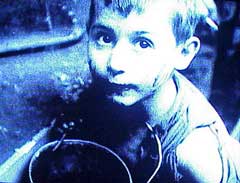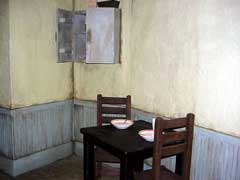In this section of the exhibit, visitors enter a dark narrow passageway containing arches that resemble the crumbling stonework of cities damaged by bombs and fire during the war. Four video monitors display footage from France and Great Britain; Greece and Italy; the Soviet Union and Eastern Europe; and Germany; showing the economic and political strife in those nations that followed the war. While there are no voices, the sound of a howling wind adds to the somber mood of this section.
In contrast to the developing economic boom in the United States, postwar Europe, devastated from the war, continued to suffer poverty, starvation, and political unrest. World War II ravaged Europe. When the fighting ended, much of the continent lay in ruins, its people dispersed, and its industry destroyed.
Two years after the war, the continent was still devastated economically. The weather added to Europe's miseries with drought, floods, and a bitter winter.
Food shortages made bad conditions worse. Looming over these crises was increasing hostility between the Soviet Union, whose armies occupied much of Eastern Europe, and the United States and its Western European allies, whose forces stood opposite the Soviets.
As economic conditions worsened, Communist parties in the nations of Western Europe, especially France and Italy, gained in strength. The possibility of popularly-elected Communist governments in Western Europe became very real. An ocean away from these troubles Americans looked on, many with rising concern.

